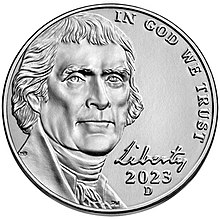United States | |
| Value | 0.05 U.S. dollar |
|---|---|
| Mass | 5.000 g |
| Diameter | 21.21 mm (0.835 in) except Shield nickels (1866–1883) 20.5 mm (0.807 in) |
| Thickness | Not specified for Shield nickels. All others: 1.95 mm |
| Edge | smooth |
| Composition | "War Nickels" (mid-1942 to 1945): |
| Silver | 1942 to 1945 Wartime Nickels only (with large mint mark on reverse) 1.750 g 0.05626 troy oz |
| Years of minting | 1866–present (except 1922, 1932, and 1933) |
| Obverse | |
 | |
| Design | Thomas Jefferson |
| Designer | Jamie Franki |
| Design date | 2006 |
| Reverse | |
 | |
| Design | Monticello |
| Designer | Felix Schlag |
| Design date | 1938 (not used in 2004 or 2005). Coins before 2006 do not have "FS" on reverse to right of Monticello. |
A nickel is a five-cent coin struck by the United States Mint. Composed of cupronickel (75% copper and 25% nickel), the piece has been issued since 1866. Its diameter is 0.835 inches (21.21 mm) and its thickness is 0.077 inches (1.95 mm).
The silver half dime, equal to five cents, was issued from 1792 to 1873 before today's cupronickel version. The American Civil War caused economic hardship, driving gold and silver from circulation; in response, in place of low-value coins, the government at first issued paper currency. In 1865, Congress abolished the five-cent fractional currency note after Spencer M. Clark, head of the Currency Bureau (today the Bureau of Engraving and Printing), placed his own portrait on the denomination. After the successful introduction of two-cent and three-cent pieces without precious metal, Congress also authorized a five-cent piece consisting of base metal; the Mint began striking this version in 1866. The initial design of the Shield nickel was struck from 1866 until 1883, then was replaced by the Liberty Head nickel. The Buffalo nickel was introduced in 1913 as part of a drive to increase the beauty of American coinage.
The nickel is minted in its modern form as the Jefferson nickel, which was first introduced in 1938. In 2004 and 2005, special Jefferson nickel designs in honor of the bicentennial of the Lewis and Clark Expedition were issued. In 2006, the Mint reverted to using Jefferson nickel designer Felix Schlag's original reverse (or "tails" side), although a new obverse, by Jamie Franki, was substituted.
During fiscal year 2020, it cost more than 7 cents to produce a nickel;[1] the Mint is exploring the possibility of reducing cost by using less expensive metals. In 2018, over 1.26 billion nickels were produced at the Philadelphia and Denver mints.